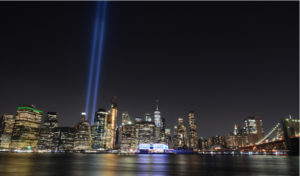
By Cory Seamer @ Shutterstock.com
September 11, 2001 is the point that most Americans see as the beginning of the new century. That day took everything Americans had known beforehand and redefined it, setting the country on a tumultuous course. Seventeen years later, the tragedy of that day is still being reconciled. The effects of that day are still present in the minds of Americans, in villages and cities in Afghanistan and the Middle East, and in the countries of Europe dealing with a wave of economic migrants.
As the world continues to hammer out the ramifications of 9/11 and all that came after it, what’s most important to remember is that on that day 2,977 people, including many children, left this world. Never forget them.
Writing in The Federalist, David Marcus, a New Yorker himself, explains what he tells his son about 9/11. He writes:
The terrorist attacks of September 11, 2001 that killed nearly 3,000 people in New York alone are not easy to talk to young kids about. Along with the sadness of so much death, there is introducing a kind of evil that would kill thousands of innocents out of depthless hatred. For kids, especially kids in New York City, comes the fear of it happening again.
When the time came to tell our son, my wife stumbled upon a remarkable resource. In 2002, Maira Kalman wrote and created the art for an extraordinary children’s book called “Fireboat: The Heroic Adventures of the John J. Harvey.” The beautifully illustrated book tells the story of a decommissioned fireboat bought and restored by some friends for fun. On 9/11, the boat not only helped ferry people from lower Manhattan, it was pressed into its original service and once again put out fires.
The book’s focus on positive action while not being shy about what really happened that day makes it a great introduction to the tragic events. The power and magnitude of the destruction come through particularly in two double full-page gouache illustrations. The first is a simple blue sky, with two plain dark planes moving toward the gleaming towers.
The next is an enormous explosion done with broad brush strokes in gray and black, with flashes of red. The words below read, “The sky was filled with fire and smoke. The buildings exploded and fell down to the ground. Many people were hurt. Many lives were lost.”
As my son grew a little older, the questions became more complicated. Why did the terrorists hate us so much? Did you know anyone who died? Was everyone really sad? I find myself wondering whether I should share the emotional impact 9/11 had on the only city he’s ever lived in, and on America as a whole. Is it wise or even possible to express that level of trauma to a child?
Images are burned into the minds of those in New York City on 9/11 and the weeks and months after. Entire walls in subway stations filled with hundreds of photocopied photographs placed by loved ones desperately seeking information. I remember one face in particular. It was a young Asian man wearing a Phillies cap. That’s my favorite team. I never met him, but I can still see his face.
Over time, it became clear hope was lost of finding them, but the photographs remained. They stayed up in many cases for weeks. They took on a new purpose. The city had collectively decided they were works of art, monuments to our grief. As the city slowly went back to something like normal, it did so under the victims’ gaze.
These are the kinds of stories that I tell my son, but I also tell happier stories. It is almost impossible for any event to saturate New York City. When the Super Bowl was in town, outside of Times Square, you would basically have had no idea. September 11, 2001 was the first time I ever saw anything saturate New York City. It was part of everything, from Yankees games to theater to local news — just everything.
Read more here.




